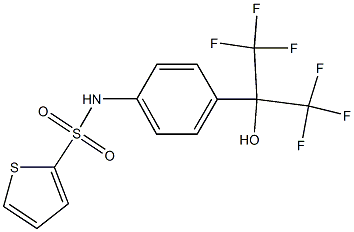293753-05-6
 293753-05-6 結(jié)構(gòu)式
293753-05-6 結(jié)構(gòu)式
基本信息
N-[4-[2,2,2-三氟-1-羥基-1-(三氟甲基)乙基]苯基]-2-噻吩磺酰胺
SR3335
SR3335
ML176
ML-176
SR-3335
ML-176
SR 3335
SR-3335
ML176
ML 176
SR3335
ML-176
SR 3335
SR-3335
ML176
ML 176
SR 3335 (This product is only available in Japan.)
N-[4-(1,1,1,3,3,3-Hexafluoro-2-hydroxypropan-2-yl)phenyl]thiophene-2-sulfonamide
N-[4-[2,2,2-Trifluoro-1-hydroxy-1-(trifluoromethyl)ethyl]phenyl]-2-thiophenesulfonamide
2-Thiophenesulfonamide, N-[4-[2,2,2-trifluoro-1-hydroxy-1-(trifluoromethyl)ethyl]phenyl]-
物理化學(xué)性質(zhì)
常見(jiàn)問(wèn)題列表
Ki: 220 nM (RORα)
SR3335 is a selective RORα partial inverse agonist. In a biochemical radioligand binding assay using [
3
H]25-hydroxycholesterol as a label it is clear that unlabeled SR3335 dose-dependently competes for binding to the RORα LBD. The K
i
is calculated as 220 nM using the Cheng-Prusoff equation. In a cell-based chimeric receptor Gal4 DNA-binding domain-NR ligand binding domain cotransfection assay, SR3335 significantly inhibits the constitutive transactivation activity of RORα (IC
50
=480 nM)(partial inverse agonist activity), but has no effect on the activity of LXRα and RORγ.
SR3335 suppresses the expression of endogenous RORα target genes in HepG2 cells that are involved in hepatic gluconeogenesis including glucose-6-phosphatase (G6Pase) and phosphoenolpyruvate carboxykinase (PEPCK).
SR3335 also blocks IL-25 and IL-33-induced ILC2 proliferation and IL-13 production ex vivo.
SR3335 displays reasonable exposure following an i.p. injection into mice. The ability of SR3335 is assessed to suppress gluconeogenesis using a diet induced obesity (DIO) mouse model where the mice where treated with 15 mg/kg b.i.d., i.p. for 6-days followed by a pyruvate tolerance test. SR3335 treated mice displays lower plasma glucose levels following the pyruvate challenge consistent with suppression of gluconeogenesis. Importantly, mice treated with SR3335 displayed no difference in body weight or food intake after 7-days of treatment with SR3335.
SR3335 (15 mg/kg/day; ip for 7 days) reduces rhinovirus (RV)-induced lung ILC2s in immature mice (RV infection of 6-day-old BALB/c mice).